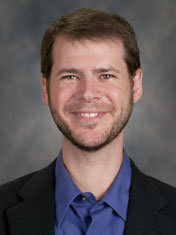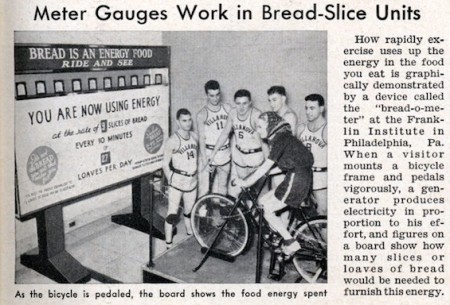Marc Abrahams's Blog, page 385
August 17, 2014
Human energy expenditure, in bread-slice units
Human energy expenditure can be measured in meaningful units, is one possible message of this May 1938 article in Popular Science:
Meter Gauges Work in Bread-Slice Units
How rapidly exercise uses up the energy in the food you eat is graphically demonstrated by a device called the “bread-o-meter” at the Franklin Institute in Philadelphia, Pa. When a visitor mounts a bicycle frame and pedals vigorously, a generator produces electricity in proportion to his effort, and figures on a board show how many slices or loaves of bread would be needed to furnish this energy.
The article does not specify the type of bread, or give specific clues as to its composition and approximate energy content.

August 16, 2014
Effect of clock ticking on how people answered a quick questionnaire
Some psychologists interpret subtle clues, thus to deepen their understanding of human nature. Here are two examples.
 “The Clock Is Ticking,” Justin H. Moss and Jon K. Maner [pictured here], Human Nature, epub April 2014. The authors, at Florida State University [Professor Maner has since moved to Northwestern University], explain:
“The Clock Is Ticking,” Justin H. Moss and Jon K. Maner [pictured here], Human Nature, epub April 2014. The authors, at Florida State University [Professor Maner has since moved to Northwestern University], explain:
The “biological clock” serves as a powerful metaphor that reflects the constraints posed by female reproductive biology. The biological clock refers to the progression of time from puberty to menopause, marking the period during which women can conceive children. Findings from two experiments suggest that priming the passage of time through the sound of a ticking clock influenced various aspects of women’s (but not men’s) reproductive timing….
Participants were randomly assigned to complete measures in either the presence or absence of a ticking clock (a small white kitchen timer). The clock was located on a table and was both visible and audible to the participant. Participants in the control condition completed the survey in a silent room… [They then answered four survey questions]: (1) “How old do you think you’ll be when you get married?” (2) “If you were to get married, in how many years from now do you think you’ll want to get married?” (3) “How old do you think you’ll be when you have your first child?” (4) “If you were to have children, in how many years from now do you think you’ll want to have your first child?”
… In conclusion, the current research suggests that priming the passage of time via the sound of a ticking clock affects important aspects of social decision-making.
Professor Maner is also an expert on the significance of the relative lengths of a person’s second and fourth fingers:
“Confronting intrasexual rivals: 2D:4D digit ratio predicts behavioral and endocrinological responses to infidelity threat,” Jon K. Maner, S. L. Miller, J. M. Coyle and M. P. Kaschak, Social Psychological and Personality Science, vol. 5, 2014, pp. 119-128.

August 15, 2014
Dr. Light – Dracula & Transylvanian implications investigator
 Foresighted though he may have been, when Bram Stoker wrote ‘Dracula’ in 1897 it’s unlikely that he considered the possible (future) impact on the Transylvanian economy and politico-cultural identity. But impact there is. And it’s been quite comprehensively examined by Dr. Light, Visiting Research Fellow at the School of Science & The Environment, Manchester Metropolitan University, UK. He has written, perhaps more than anyone, on the implications of Dracula Tourism in Romania.
Foresighted though he may have been, when Bram Stoker wrote ‘Dracula’ in 1897 it’s unlikely that he considered the possible (future) impact on the Transylvanian economy and politico-cultural identity. But impact there is. And it’s been quite comprehensively examined by Dr. Light, Visiting Research Fellow at the School of Science & The Environment, Manchester Metropolitan University, UK. He has written, perhaps more than anyone, on the implications of Dracula Tourism in Romania.
See, for examples(s):
• Light, D. (2012) The Dracula Dilemma: Tourism, Identity and the State in Romania, Ashgate, Farnham. ISBN 978-1409440215
• Light, D. (2012) ‘Taking Dracula on holiday: The presence of ‘home’ in the tourist encounter’, in L. Smith, E. Waterton and S. Watson (eds) The Cultural Moment in Tourism, Routledge, London, 59-78
• Light, D. (2007) ‘Dracula tourism in Romania: Cultural Identity and the State’, Annals of Tourism Research 34 (3), 746-765
Also see: Economics of the undead, arise bookishly! and Dracula research resources.

The man who drove, blinding himself, on Route 128 — for your safety
[Ig Nobel Prize winner] John Senders led a series of safety experiments in which he drove an automobile on Route 128 — the major highway that circles Boston to the west — while a visor repeatedly flapped down over his face, blinding him….
—so begins another Improbable Innovation nugget, which appears in its entirety on BetaBoston.

August 14, 2014
Effects of East Anglian breast screening on climate change
A newly appreciated problem — climate change, for example — can spur people to consider all sorts of possible remedies. This study appears to have been done in that spirit:
“Tackling climate change close to home: mobile breast screening as a model,” Alan Bond, Andrew Jones, Robin Haynes, Matthew Tam, Erika Denton, Mandy Ballantyne, and John Curtin, Journal of Health Services Research & Policy, vol. 14, no. 3 (2009): 165-167. (Thanks to investigator Knud Nairz for bringing this to our attention.) The authors, at the University of East Anglia and at Norfolk and Norwich University Hospital, explain:
Health services contribute significantly to carbon dioxide (CO2) emissions and, while services in the UK are beginning to address this, the focus has been on reducing energy consumption rather than road transport, a major component of emissions. We aimed to compare the distances travelled by patients attending mobile breast screening clinics compared to the distance they would need to travel if screening services were centralized….
The availability of mobile breast screening clinics for the 60,675 women who underwent screening over a three-year cycle led to a return journey distance savings of 1,429,908 km. Taking into account the CO2 emissions of the tractor unit used for moving the mobile clinics around, this equates to approximately 75 tonnes of CO2 saved in any one year.
BONUS: Solve climate change… make people smaller

August 13, 2014
A (or an) historian muses about history and the Ig Nobel Prizes
Historian William G. Pooley, in his blog, muses about history and the Ig Nobel Prizes:
Who cares about the funny little people you spend your time researching? What do you think people really learn from studying the family lives, emotions, or sexuality of our ancestors, beyond soft ideas of cultural relativity or platitudes about the importance of tolerance, reason, and understanding? Whose life are you saving with your ‘research’? Who will even read it? ….
[My thoughts wandered] to the one of my favourite annual silly stories: the igNobel awards. These alternatives to the Nobel science prizes, in the words of their website, honour ‘Research that makes people laugh, and then think’ .
I think there would be quite a lot of interest in a similar kind of thing for history (or indeed other humanities). Just think of the number of times people in social situations comment to you about how ‘specific’ your research is, often meaning irrelevant and unimportant. Yet when I tried to think of a list of works of ‘bad history’, I quickly found my brain racing to find explanations for why apparently inconsequential topics are actually vitally important.
Think of the weird mind of the sixteenth-century miller, Menocchio, which Carlo Ginzburg used to probe how humble people in the Renaissance read books, and how oral and print cultures mingled in the worldviews of ordinary people.
A different example: forty years ago, who would have been interested in the bizarre records that nineteenth-century schools, prisons, and other institutions kept about waist and height measurements? But the booming field of historical anthropometrics has revolutionized historians’ understanding of poverty and exploitation in the recent past by using these records to work out how well-fed and how healthy men, women, and children were….
NOTE: Happy news for investigator Pooley! The Ig Nobel Prizes are in fact given for achievements, not just in science, but in any field of human endeavor or happenstance. Here’s the complete list of winners.

The Psychoanalytic Geography of Alan Partridge
Preamble: Alan Gordon Partridge is a (fictional) TV and Radio presenter, based in Norfolk, UK. For further info, Youtube currently hosts a three-part (fictional) TV documentary about his (fictional) life : part 1 part 2 part 3
What have Lacan and Foucalt to do with Alan Partridge? For answers, see the work of Paul Kingsbury, who is an Associate Professor at Simon Fraser University, Burnaby, B.C. Canada, and who is a “Psychoanalytic Geographer” (*see explanatory note below) The professor presents a new paper in the journal Cultural Geographies May 29, 2014. ‘Becoming literate in desire with Alan Partridge’
It cites the Partridgesque behaviours seen above (the air guitar performance and the Inland Revenue inspectors’ visit) and explores possible relevancies that Alan Partridge might have with the work of Jaques Lacan, [+ve link , -ve link ] and Michel Foucalt [+ve link , -ve link ]
Here’s a sample excerpt :
“For Lacan, the human subject desires insofar as she or he is a speaking-being or a ‘parlêtre’ to use Lacan’s neologism that joins being (l’être) with speaking (parler). As Partridge tells us, ‘Chat is what I do’ and despite ‘being crushed by a dead cow . . . encountering “mentalist” fans . . . [or] suffering a breakdown, Toblerone addiction and skewering his foot on a spike he always bounces back’. Furthermore, Partridge’s speech, specifically, his vocabulary, tonalities, facial expressions, mannerisms, and so on teem with uneasy confidence, nervousness, and volatility. In so doing, Partridge brings to the fore the ways in which language is menaced and littered by the inscriptions of negation.”
* note : The professor is co-editor (along with professor , Open University, UK) of a new book entitled Psychoanalytic Geographies
“Psychoanalytic Geographies is a unique, path-breaking volume and a core text for anyone seeking to grasp how psychoanalysis helps us understand fundamental geographical questions, and how geographical understandings can offer new ways of thinking psychoanalytically. “
BONUSES :(related)
• The paper alerts us to a (mock) website for the Linton Travel Tavern.
• The (official) history of Toblerone™

August 12, 2014
Assessing the Perceived Personalities of Rocks
Of these three rocks, which would you say is the most ‘confident’ ?
How about the most ‘sincere’ or ‘intelligent’? Just such questions were asked in a recent study by Dr. Mark Avis (Massey University, New Zealand), Dr. Sarah Forbes (University of Birmingham, UK) and Dr. Shelagh Ferguson (University of Otago, New Zealand). Their study examined the (perceived) personalities – specifically the Brand Personalities (BP) – of the three rocks shown above. Experimental results showed that Rock G was the most glamorous and also the most contemporary, whilst rock H was the most sentimental, and rock I was the most independent.
See: ‘The brand personality of rocks: A critical evaluation of a brand personality scale’ Marketing Theory, December 6, 2013.
Background Notes on BP
The concept of ‘Brand Personality’ was developed in 1997 by Jennifer L. Aaker, who is General Atlantic Professor of Marketing, Ormond Family Faculty, Graduate School of Business, Knight Management Center, Stanford University. The professor’s paper ‘Dimensions of Brand Personality ‘ (Journal of Marketing Research, Aug. 1997) suggested that it might be possible to rate a diverse range of commercial product and services (e.g Bic razors, Marlboro cigarettes, Marriot hotels etc.) according to their perceived ‘personality’ traits. (e.g. cheerful, confident, intelligent etc.)
Similar techniques – such as the Young and Rubicam BrandAsset™ Valuator (which is cited in the paper above) are currently widely used in the advertising / marketing industries.

The ‘godfather of graphene’, the frog, and the spoon
Intelligent Life magazine profiled Ig Nobel Prize winner (and also Nobel prize winner) Andre Geim, under the headline “The Godfather of Graphene“. Here’s a snippet:
“Somehow I measure my life and longevity not in years but in the number of accumulated experiences,” he says. Many of these experiences are mountains he has climbed. One is finding a use for an extremely powerful magnet at a university in Holland in the late 1990s. He levitated a frog, and even though this demonstrated nothing new about magnetism, it attracted grants, attention and job offers. It marked him out as a prankster and earned him an Ig Nobel prize from Harvard. Against the advice of more self-important scientists he showed up to collect the prize and, the organisers remember, “was constantly running around telling dirty jokes”. He was especially fond of showing the kind of imagery to be obtained from the reflection of two fingers in a spoon.

August 11, 2014
Small study suggests suggesting that if women quit smoking, they will think they get bigger breasts
This tiny Italian study examined the gently-directed breast-centric introspection of a few women who had recently quit smoking. The study is:
“Breast change perception in women after smoking cessation. A pilot study,” Cinzia De Marco, Giovanni Invernizzi, , , Anna Villarini, Elena Munarini, , and [pictured below], Tumori, vol. 97, no. 5, pp. 672-675.
The authors, at Istituto Nazionale dei Tumori, Milan, Italy, explain:
A pilot study to evaluate the perception of breast change after cessation [of smoking] and its possible motivational effect on maintenance was carried out. We interviewed 25 premenopausal women who had quit ≥1 year before….
The participants were interviewed by telephone with an open-ended questionnaire (see appendix) about changes in breast size and consistency, weight gain, and dietary and physical activity changes occurring within 3-6 months after smoking cessation. We defined ‘breast change’ as an increase in breast size and/or fullness as experienced by the study women after quitting smoking….
With limitations due to an observational pilot study without a control group, our results indicate that over half of the participants reported breast increase at 6 months…
Further studies are needed to verify this hypothesis; if confirmed, the data could be used as a new motivational tool adding to those already known, such as better skin and muscular oxygenation, which have positive effects from both an aesthetic and psychophysical point of view.
(Thanks to investogator Francis Villatoro for bringing this to our attention.)
BONUS [possibly unrelated]: the 2013 Ig Nobel Psychology Prize-winning study “Beauty Is in the Eye of the Beer Holder’: People Who Think They Are Drunk Also Think They Are Attractive“

Marc Abrahams's Blog
- Marc Abrahams's profile
- 14 followers





